Arterial blood gases abgs Study guides, Class notes & Summaries
Looking for the best study guides, study notes and summaries about Arterial blood gases abgs? On this page you'll find 1074 study documents about Arterial blood gases abgs.
Page 2 out of 1.074 results
Sort by
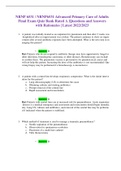
-
NRNP 6531 / NRNP6531 Advanced Primary Care of Adults Final Exam Quiz Bank Rated A |Questions and Answers with Rationales | Latest 2022/2023
- Exam (elaborations) • 96 pages • 2023
-
- $10.99
- 1x sold
- + learn more
NRNP 6531 / NRNP6531 Advanced Primary Care of Adults Final Exam Quiz Bank Rated A |Questions and Answers with Rationales | Latest 2022/2023 1. A patient was initially treated as an outpatient for pneumonia and then after 2 weeks was hospitalized after no improvement was evident. The patient continues to show no improvement after several antibiotic regimens have been attempted. What is the next step in managing this patient? ~ Answer: D Rat: Patients who do not respond to antibiotic th...
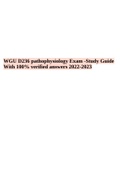
-
WGU D236 pathophysiology OA Exam -Study Guide With 100% verified answers 2022-2023.
- Exam (elaborations) • 28 pages • 2023
- Available in package deal
-
- $10.49
- 2x sold
- + learn more
WGU D236 pathophysiology AO Exam -Study Guide With 100% verified answers 2022-2023. Patho OA Study Guide 1. What is Starling's Law of Capillary forces? How does this explain why a nutritionally deficient child would have edema? Starling’s Law describes how fluids move across the capillary membrane. There are two major opposing forces that act to balance each other, hydrostatic pressure (pushing water out of the capillaries) and osmotic pressure (including oncontic pressure, which pu...
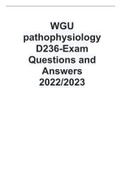
-
WGU pathophysiology D236-Exam Questions and Answers 2022-2023
- Exam (elaborations) • 43 pages • 2022
-
- $15.99
- 5x sold
- + learn more
WGU pathophysiology D236-Exam Questions and Answers 2022/2023 What is Starling's Law of Capillary forces? How does this explain why a nutritionally deficient child would have edema? - ANSWER Starling's Law describes how fluids move across the capillary membrane. There are two major opposing forces that act to balance each other, hydrostatic pressure (pushing water out of the capillaries) and osmotic pressure (including oncontic pressure, which pushes fluid into the capillaries). Bot...
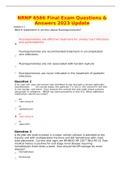
-
NRNP 6566 Final Exam Questions & Answers 2023 Update
- Exam (elaborations) • 36 pages • 2023
-
- $19.89
- 1x sold
- + learn more
NRNP 6566 Final Exam Questions & Answers 2023 Update NRNP 6566 Final Exam Questions & Answers 2023 Update Question 1 Which statement is correct about fluoroquinolones? fluoroquinolones are effective treatment for urinary tract infections and pyelonephritis Fluoroquinolones are recommended treatment in uncomplicated skin infections fluoroquinolones are not associated with tendon rupture fluoroquinolones are never indicated in the treatment of pediatric infections Question 2 A 42...
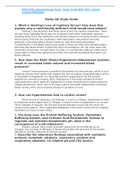
-
WGU D236 pathophysiology Exam -Study Guide-With 100% verified answers-2022-2023
- Exam (elaborations) • 26 pages • 2022
-
- $9.79
- 4x sold
- + learn more
1. What is Starling's Law of Capillary forces? How does this explain why a nutritionally deficient child would have edema? Starling’s Law describes how fluids move across the capillary membrane. There are two major opposing forces that act to balance each other, hydrostatic pressure (pushing water out of the capillaries) and osmotic pressure (including oncontic pressure, which pushes fluid into the capillaries). Both electrolytes and proteins (oncontic pressure) in the blood affect osmot...
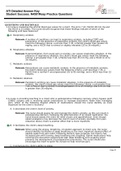
-
ATI Detailed Answer Key Student Success. N4581Resp Practice Questions
- Exam (elaborations) • 20 pages • 2022
-
- $15.99
- 5x sold
- + learn more
ATI Detailed Answer Key Student Success. N4581Resp Practice Questions QUESTIONS AND RATIONALE 1. A nurse is reviewing the arterial blood gas values for a client. The pH is 7.32, PaCO2 48 mm Hg and the HCO3 is 23 mEq/L. The nurse should recognize that these findings indicate of which of the following acid base balances? A. Respiratory acidosis Rationale: A number of conditions can lead to respiratory acidosis, including COPD and pneumonia. In the presence of respiratory acidosis, the cli...
![Critical Care exam 1: respiratory Practice questions { QUESTIONS AND CORRECT DETAILED ANSWERS |ALREADY GRADED A+ (BRAND NEW!! 2024/ 2025[NEXT GEN] }](/docpics/4601840/65dc418b7c7fe_4601840_121_171.jpeg)
-
Critical Care exam 1: respiratory Practice questions { QUESTIONS AND CORRECT DETAILED ANSWERS |ALREADY GRADED A+ (BRAND NEW!! 2024/ 2025[NEXT GEN] }
- Exam (elaborations) • 31 pages • 2024
-
- $15.49
- + learn more
Critical Care exam 1: respiratory Practice questions { QUESTIONS AND CORRECT DETAILED ANSWERS |ALREADY GRADED A+ (BRAND NEW!! 2024/ 2025[NEXT GEN] } 1) A nurse is caring for a patient with ARDS. The nurse views the ABG. What value should the nurse report to the physician? pH: 7.35 PaCO2: 26mmhg PaO2:95 HCO3: 22 a) PaCO2 b)pH c)HCO3 d)PaO2 - CORRECT ANSWER a A client admitted with respiratory difficulty and decreased oxygen saturation keeps pulling off the oxygen mask. What...

-
ACUTE RESP DISTRESS SYNDROME (ARDS) Answered with Complete Rationales 100% all correct!
- Exam (elaborations) • 24 pages • 2023
-
- $13.49
- 1x sold
- + learn more
ACUTE RESP DISTRESS SYNDROME (ARDS) 1. The unlicensed assistive personnel (UAP) is bathing the client diagnosed with acute respiratory distress syndrome (ARDS). The bed is in a high position with the opposite side rail in the low position. Which action should the nurse implement? 1. Demonstrate the correct technique for giving a bed bath. 2. Encourage the UAP to put the bed in the lowest position. 3. Instruct the UAP to get another person to help with the bath. 4. Provide praise for perform...
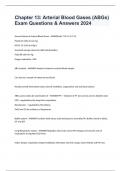
-
Chapter 13: Arterial Blood Gases (ABGs) Exam Questions & Answers 2024
- Exam (elaborations) • 5 pages • 2024
- Available in package deal
-
- $7.99
- + learn more
Chapter 13: Arterial Blood Gases (ABGs) Exam Questions & Answers 2024 Normal Values of Arterial Blood Gases - ANSWER-pH 7.35-(7.4)-7.45 PaCO2 35-(40)-45 mm Hg HCO3- 22-(24)-26 mEq/L Assumed average values for ABG interpretation PaO2 80-100 mm Hg Oxygen saturation >94% ABG analysis - ANSWER-Analysis is based on arterial blood sample Can also be a sample of mixed venous blood Results provide information about alveoli ventilation, oxygenation and acid base balance ABGs asse...
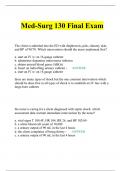
-
Med-Surg 130 Final Exam 2024
- Exam (elaborations) • 59 pages • 2024
- Available in package deal
-
- $12.49
- + learn more
Med-Surg 130 Final Exam The client is admitted into the ED with diaphoresis, pale, clammy skin, and BP of 90/70. Which intervention should the nurse implement first? a. start an IV w/ an 18-gauge catheter b. administer dopamine intravenous infusion c. obtain arterial blood gases (ABGs) d. Insert an indwelling urinary catheter - ANSWER a. start an IV w/ an 18 gauge catheter there are many types of shock but the one common intervention which sh...

Did you know that on average a seller on Stuvia earns $82 per month selling study resources? Hmm, hint, hint. Discover all about earning on Stuvia


